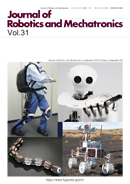Volume 31, Issue 5
Displaying 1-9 of 9 articles from this issue
- |<
- <
- 1
- >
- >|
Regular Papers
-
Article type: Paper
2019Volume 31Issue 5 Pages 647-656
Published: October 20, 2019
Released on J-STAGE: October 20, 2019
Download PDF (1119K) -
Article type: Paper
2019Volume 31Issue 5 Pages 657-670
Published: October 20, 2019
Released on J-STAGE: October 20, 2019
Download PDF (2098K) -
Article type: Paper
2019Volume 31Issue 5 Pages 671-685
Published: October 20, 2019
Released on J-STAGE: October 20, 2019
Download PDF (4027K) -
Article type: Paper
2019Volume 31Issue 5 Pages 686-696
Published: October 20, 2019
Released on J-STAGE: October 20, 2019
Download PDF (1328K) -
Article type: Paper
2019Volume 31Issue 5 Pages 697-706
Published: October 20, 2019
Released on J-STAGE: October 20, 2019
Download PDF (1901K) -
Article type: Development Report
2019Volume 31Issue 5 Pages 707-714
Published: October 20, 2019
Released on J-STAGE: October 20, 2019
Download PDF (1141K) -
Article type: Letter
2019Volume 31Issue 5 Pages 715-718
Published: October 20, 2019
Released on J-STAGE: October 20, 2019
Download PDF (3044K)
Latest Research Topics
-
Article type: News
2019Volume 31Issue 5 Pages 720-722
Published: October 20, 2019
Released on J-STAGE: October 20, 2019
Download PDF (315K) -
Article type: News
2019Volume 31Issue 5 Pages 723-726
Published: October 20, 2019
Released on J-STAGE: October 20, 2019
Download PDF (2149K)
- |<
- <
- 1
- >
- >|
